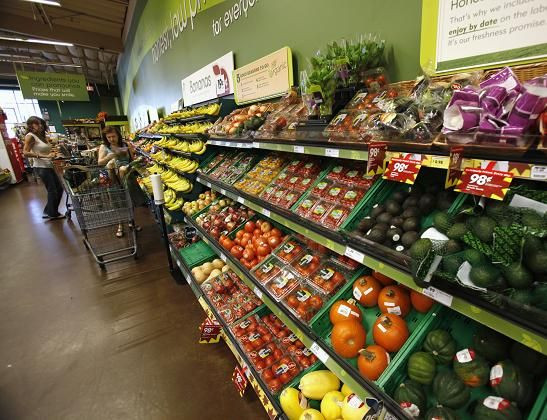Food Prices To Keep Rising As Drought, Demand And Disease Strain Supply

Food prices have been on the rise across America in recent months as a deluge of detrimental factors has descended on key sectors of the agricultural industry.
The pig-farming industry was hit hard by deadly disease. Oranges, limes, peppers and other produce experienced price spikes as the West Coast suffered through epic drought.
And a surge in the prices of beef, cheese pork and avocado made headlines last week when the Chipotle burrito and taco chain announced that it would hike its menu prices for the first time in three years.
"It has been nearly three years since our last company-wide price increase, and while we want to remain accessible to our customers, we are at a point where we need to pass along these rapidly rising food costs," said the company’s chief financial officer, Jack Hartung, Reuters reported. His is a sentiment nearly anyone in the food business can empathize with.
Experts and industry insiders often agree about some of the basic underlying causes of these temporary jumps in prices for individual commodities. But they are somewhat more divided when they take a step back to consider what the long-term outlook is for the agricultural industry as a whole.
These questions are becoming ever more vital as the world’s population balloons and the number of farmers in advanced economies like the United States dwindles.
But one thing is clear: The world’s agricultural needs and concerns are not getting any easier to fulfill and address, and a failure to take meaningful steps to fix the shortfalls and problems facing the international food system will just mean more belt-tightening for consumers in the First World, and epic problems for populations of developing countries.
Dr. Milt McGiffen, vice chair for Extension, Department of Botany and Plant Sciences at the University of California Riverside, who is in his fifties, distinctly recalls hearing numerous reports about famines in faraway countries when he was growing up.
Widespread hunger scourges have been minimalized in recent decades, but he said that those kinds of news stories are “starting to come back” as the world struggles to feed its citizenry in an efficient and cost-effective manner.
“It’s more of a problem than it was and we’re getting to where we have more people than we can feed so we need to do something one way or another,” McGiffen explained.
“For Americans, only about 6 percent of our income goes to food. … If it went up 20 percent, that’s only maybe one more percent of your income going to food. But around the world where people spend more than half their money on food, they will not be able to survive. What would happen first is you’d start to hear more famine stories.”
The factors driving the burgeoning demand and diminishing supply for the world’s limited food resources vary depending on the individual crop or food item, but over the long term they will continue to rise.
Mark Allison, senior vice president for culinary and kitchen operations at Chanticleer Holdings, the Charlotte, N.C.-based company that owns international rights to popular chain restaurants including Hooters and American Roadside Burgers, said prices have risen quite precipitously in certain key markets.
The price of ground beef has shot up 56 percent since 2010, he said, a price increase that will only continue to get worse for the next 18 to 24 months as the U.S. grapples with the lowest number of cattle being slaughtered in 63 years.
“This is the least amount of beef we’ve had since 1951,” Allison said. “It’s roundabout the same number of cows we’ve had since 1951, but obviously the population of America has multiplied in that time.”
Allison’s comments echo those of Hartung, who said last week that "beef prices are expected to continue to move higher as supply remains tight."
But agriculture insiders like Mike Conrad, president of Spokane, Wash.-based meat wholesaler Zaycon Foods, said that although meat prices are rising, people should be aware that much of the concern over the food supply is driven by “hype” and breathless media reports that fail to appreciate the cycles and unexpected events that wield great influence on food prices.
“Prices will continue to rise. But people get skittish and especially with the world of social media today, it actually creates a mountain out of a molehill. I’m not too worried about it, I’ve had some increase but not huge increases,” Conrad explained, adding, “Stores take advantage of the opportunity, so once reporters start talking about prices going up, stores take advantage of people’s fear.”
Either way, experts agree food prices will soar ever higher over coming decades as billions more people are born, further increasing demand and stretching the Earth’s limited resources.
McGiffen said there are myriad ways to start to bridge the food gap, but that implementing them will require a concerted and deliberate effort.
“There are proposals,” he said. “We need to control our population. We need to use our resources efficiently. The one thing farmers will say over and over again -- and you’ll hear this in every industry -- is they will say they need to have less regulations.”
But overall, the future of farming and eating will come down to the ability of humans to come together and work to address these major challenges in creative and effective ways.
“We used to do a lot of research in ag, and we did our job too well, and food became cheap and plentiful so now there’s fewer and fewer people looking at these issues,” McGiffen explained.
“We’re going to have to decide where our priorities are.”
© Copyright IBTimes 2025. All rights reserved.





















